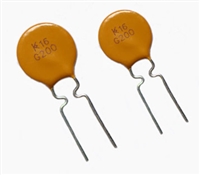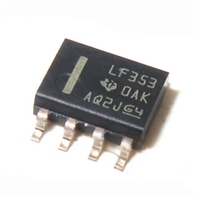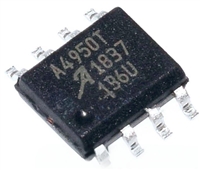AD630
LVDT SIGNAL CONDITIONER
10k⍀
10k⍀
DIFF
ADJ
CM
ADJ
Many transducers function by modulating an ac carrier. A Lin-
ear Variable Differential Transformer (LVDT) is a transducer of
this type. The amplitude of the output signal corresponds to
core displacement. Figure 20 shows an accurate synchronous
demodulation system which can be used to produce a dc voltage
which corresponds to the LVDT core position. The inherent
precision and temperature stability of the AD630 reduce de-
modulator drift to a second order effect.
6
4
3
5
2.5k⍀
2.5k⍀
MODULATION
INPUT
1
2
AMP A
12
11
13
A
+V
S
20
B
10k⍀
MODULATED
OUTPUT
SIGNAL
17
18
AMP B
14
15
16
–V
10k⍀
19
AD630
CARRIER
INPUT
E1000
5k⍀
COMP
AD544
SCHAEVITZ
A
7
AD630
؎2 DEMODULATOR
9
FOLLOWER
16
LVDT
5k⍀
B
10
8
15
10k⍀
2.5k⍀
10k⍀
1
2.5kH
Z
A
B
20
19
–V
C
S
100k⍀
1F
2V p-p
13
D
14
17
SINUSOIDAL
EXCITATION
Figure 18b. AD630 Configured as a Gain-of-Two Balanced
Modulator
12
2.5k⍀
9
PHASE
SHIFTER
5V
20s
5V
10
MODULATION
INPUT
Figure 20. LVDT Signal Conditioner
AC BRIDGE
Bridge circuits which use dc excitation are often plagued by
CARRIER
INPUT
errors caused by thermocouple effects, 1/f noise, dc drifts in the
electronics, and line noise pick-up. One way to get around these
problems is to excite the bridge with an ac waveform, amplify
the bridge output with an ac amplifier, and synchronously de-
modulate the resulting signal. The ac phase and amplitude
information from the bridge is recovered as a dc signal at the
output of the synchronous demodulator. The low frequency
system noise, dc drifts, and demodulator noise all get mixed to
the carrier frequency and can be removed by means of a low-pass
filter. Dynamic response of the bridge must be traded off against
the amount of attenuation required to adequately suppress these
residual carrier components in the selection of the filter.
OUTPUT
SIGNAL
10V
Figure 19. Gain-of-Two Balanced Modulator Sample
Waveforms
BALANCED DEMODULATOR
The balanced modulator topology described above will also act as
a balanced demodulator if a double sideband suppressed carrier
waveform is applied to the signal input and the carrier signal is
applied to the reference input. The output under these circum-
stances will be the baseband modulation signal. Higher order
carrier components will also be present which can be removed
with a low-pass filter. Other names for this function are synchro-
nous demodulation and phase-sensitive detection.
Figure 21 is an example of an ac bridge system with the AD630
used as a synchronous demodulator. The oscilloscope photo-
graph shows the results of a 0.05% bridge imbalance caused by
the 1 Meg resistor in parallel with one leg of the bridge. The top
trace represents the bridge excitation, the upper-middle trace is
the amplified bridge output, the lower-middle trace is the out-
put of the synchronous demodulator and the bottom trace is the
filtered dc system output.
PRECISION PHASE COMPARATOR
The balanced modulator topologies of Figures 18a and 18b can
also be used as precision phase comparators. In this case, an ac
waveform of a particular frequency is applied to the signal input
and a waveform of the same frequency is applied to the refer-
ence input. The dc level of the output (obtained by low-pass
filtering) will be proportional to the signal amplitude and phase
difference between the input signals. If the signal amplitude is
held constant, then the output can be used as a direct indication
of the phase. When these input signals are 90° out of phase, they
are said to be in quadrature and the AD630 dc output will be zero.
This system can easily resolve a 0.5 ppm change in bridge im-
pedance. Such a change will produce a 3.2 mV change in the
low-pass filtered dc output, well above the RTO drifts and noise.
1kHz
BRIDGE
EXCITATION
AD630
A
؎2 DEMODULATOR
16
AD524
GAIN 1000
15
1k⍀
1k⍀
1k⍀
10k⍀
5k⍀
FILTER
5k⍀
A
B
20
2
1k⍀
D
B
2.5
5k⍀ 5k⍀
13
12
k⍀
C
1
2F 2F 2F
1M⍀
PRECISION RECTIFIER-ABSOLUTE VALUE
If the input signal is used as its own reference in the balanced
modulator topologies, the AD630 will act as a precision recti-
fier. The high frequency performance will be superior to that
which can be achieved with diode feedback and op amps. There
are no diode drops which the op amp must “leap over” with the
commutating amplifier.
17
2.5
k⍀
10k⍀
14
PHASE
SHIFTER
9
10
Figure 21. AC Bridge System
REV. C
–7–






 NTC热敏电阻与PTC热敏电阻的应用原理及应用范围
NTC热敏电阻与PTC热敏电阻的应用原理及应用范围

 GTO与普通晶闸管相比为什么可以自关断?为什么普通晶闸管不能呢?从GTO原理、应用范围带你了解原因及推荐型号
GTO与普通晶闸管相比为什么可以自关断?为什么普通晶闸管不能呢?从GTO原理、应用范围带你了解原因及推荐型号

 LF353数据手册解读:特性、应用、封装、引脚说明、电气参数及替换型号推荐
LF353数据手册解读:特性、应用、封装、引脚说明、电气参数及替换型号推荐

 A4950资料手册解读:特性、应用、封装、引脚功能、电气参数及代换型号
A4950资料手册解读:特性、应用、封装、引脚功能、电气参数及代换型号
